I asked some of my Australian friends what the general impression of Adelaide was, in the rest of the country. I’d’ve done a word cloud but it turns out there wasn’t a lot of point.
“It’s a bit boring” seems to be the common theme. Like, I got the impression Adelaide was to Australia what somewhere like Winnipeg is to Canadians – a place kind of ‘out the way’ that, while not ‘dreadful’, is also a place people generally wouldn’t think of going: ‘beige’. Nice, but functional. Its main (only?!) selling point appears to be the wine in the valleys around the city.
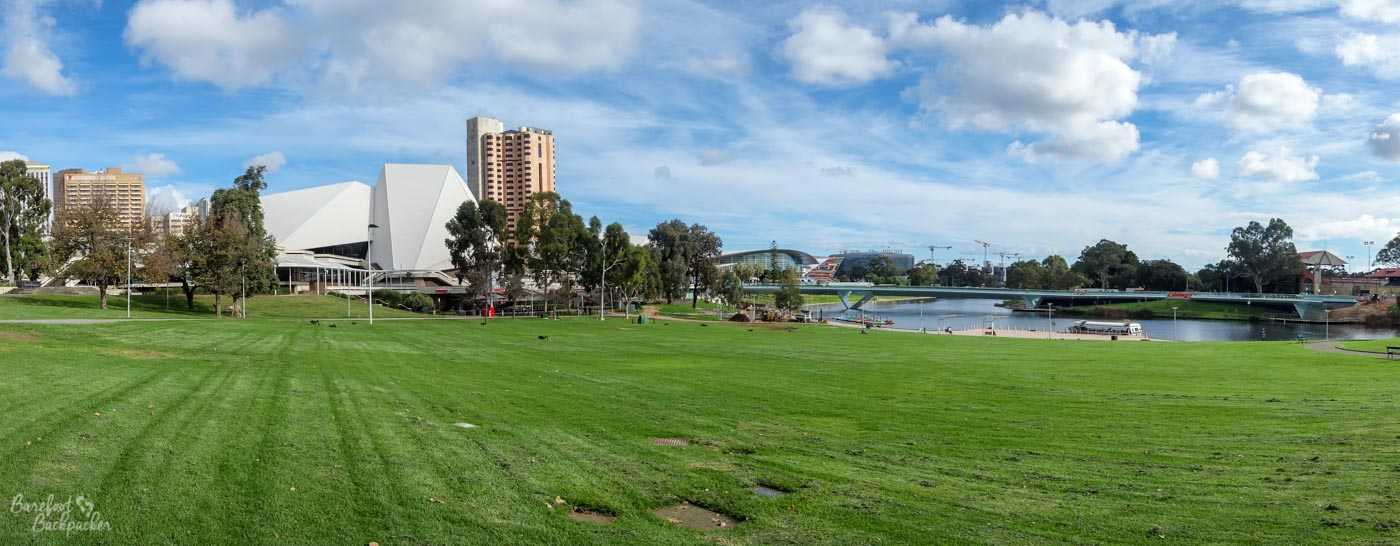
One of the green parkland areas that encircle the city of Adelaide.
Now, it must be said I went there simply because it was the next logical stopping point before going to visit my friend Lisa on the Sunshine Coast. Thus it wasn’t a place I’d specifically come to Australia to visit, more that it was a place I was going to be passing through anyway so why not stop over for a couple of days. It also wasn’t a place I knew a lot about – I’d heard of it, but more because it was a large city than for any specific reason. And they play cricket there so I’d probably heard it mentioned a lot on Test Match Special on the radio.
I ended up staying for pretty much a full four days (three nights) given my arrival and departure times, and while I never made it out to the hinterland (I’m definitely more a beer than wine person), I did have a fun time exploring points close by.
Why Adelaide appealed from the start
I was staying in a pretty centrally-located hostel (called Backpack Oz), and both the staff and the guests were very friendly, with none of the irk I’d had in Perth. The bed was the most comfortable I’d had for the entire trip, and on my first night there the hostel had free potato salad and bbq meat, followed by a pool competition (based on ‘can you pot a ball or not with each shot you take’). There must have been over 30 of us there; obviously I didn’t win …

Inside the Backpack Oz Backpacker Hostel. Fun fact – at the time of my visit you could hire DVDs to watch. One of those available was ‘Hostel’. Australians and backpackers share a very strange sense of humour.
I mention all that because it’s important to my state of mind. My indifference to Fremantle had been partly driven by my own mental state/health, but, as has happened both before and since (eg in Vilnius and Bobo-Dioulassou), the very act of moving to a new place acts as a kind of ‘reset button’ and I can almost … leave my issues behind and start afresh. As a result, it means my impressions of the new place are often much more positive than people might expect.
The Culture of Adelaide
The city itself isn’t anything unusual or out of the ordinary. It doesn’t have a defining attraction or focus point like, say, Sydney Opera House/Harbour Bridge, nor the hip vibe like the ‘coffee-culture’ of Melbourne, and it’s more ‘out the way’ than Brisbane’s role as ‘gateway to Queensland’, but I think it was exactly what I needed at that moment in time. I felt less stressed, much calmer, and more ‘in control’. It also felt quite a clean city, and at no point did I feel unsafe or need to feel wary (though to be honest I had that impression across most of Australia).
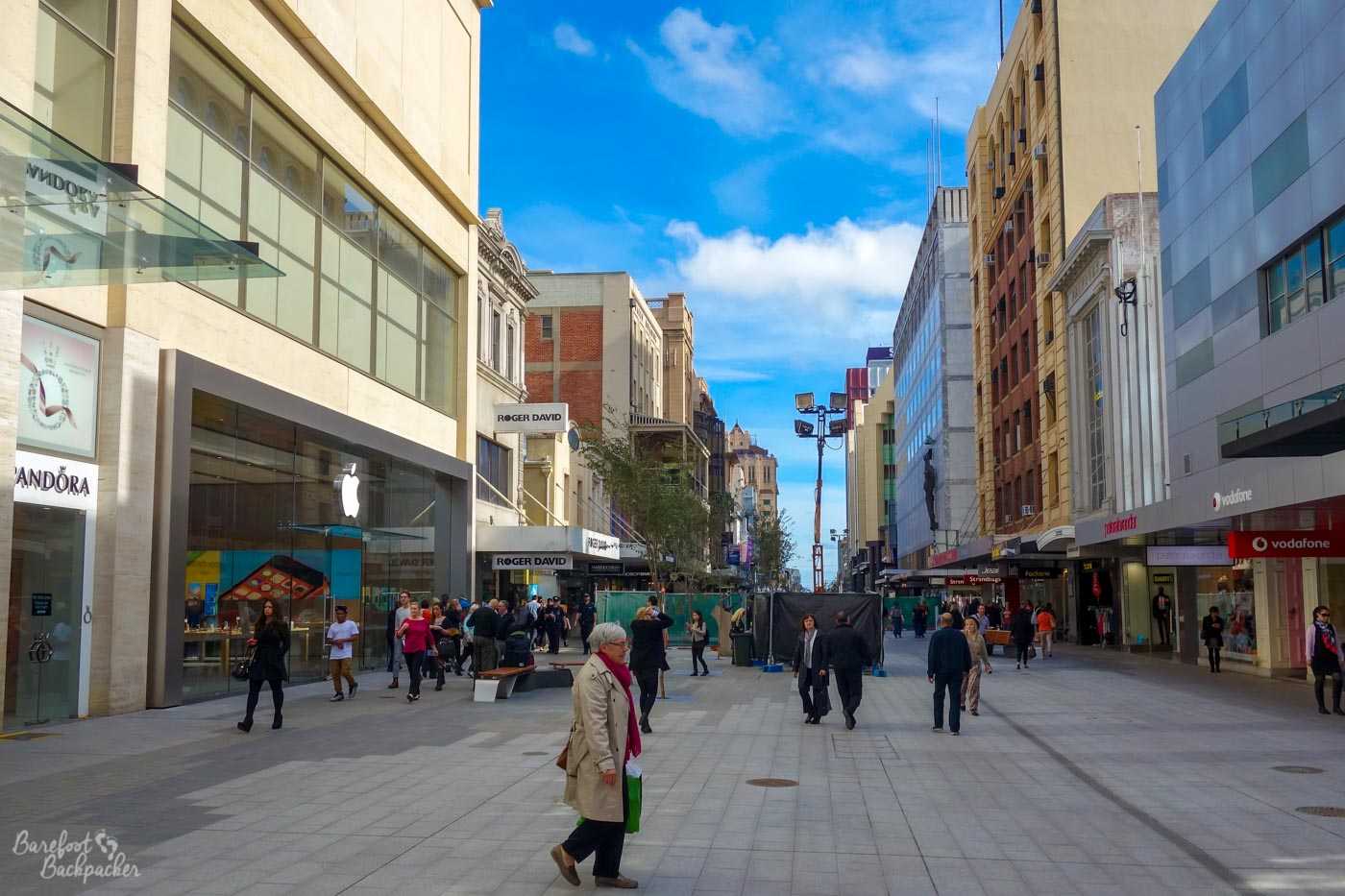
Adelaide city centre – Rundle Mall.
Like Perth, the centre of Adelaide is fairly compact and quite ‘gridded’. The main shopping area, around Rundle Mall, is fairly standard, although there are a number of quirky statues to be found, including “The Slide” by local sculptor John Dowie, but the most famous draw is a series of four pigs.

Three of the four pigs of the ‘A Day Out’ sculpture piece.
These are an installation called ‘A Day Out’, installed in 1999, and were sculpted by Marguerite Derricourt, seemingly following a sculpture competition. They’re designed to be interacted with, as well as providing an interesting draw for tourists and shoppers alike.
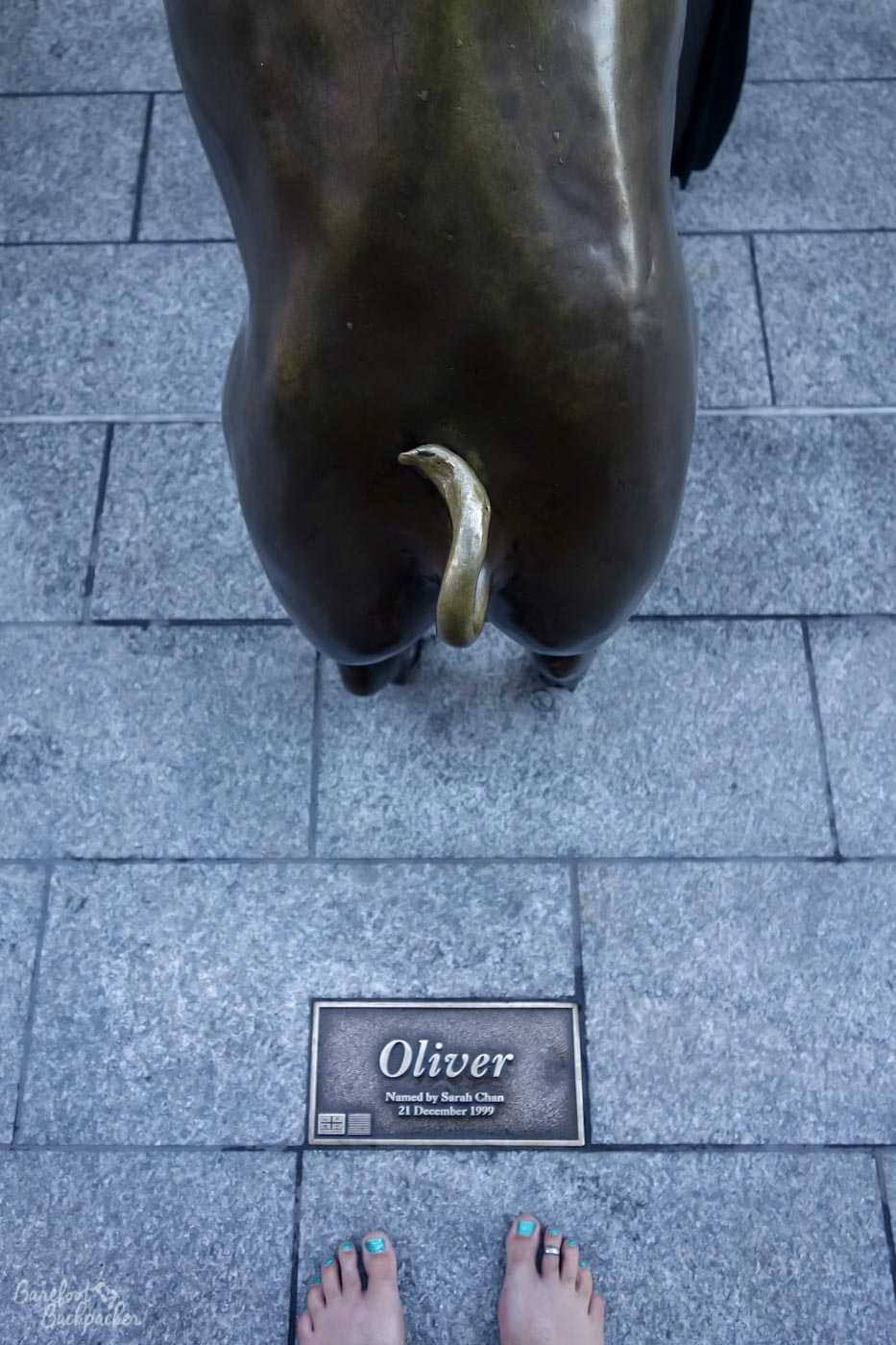
Oliver. Apt name. Feet for reference purposes only.
As mentioned earlier, the other cultural icon for me in Adelaide is the Adelaide Oval. This sports stadia was built in 1871 and, at the time of my visit to the city, was being modernised and refurbished. It’s most noted for being a cricket ground, but is also the home to two AFL teams. Not that I know anything about that sort of thing. I also seem to have missed the statue of Don Bradman, which was careless, especially as there’s one in my home town!
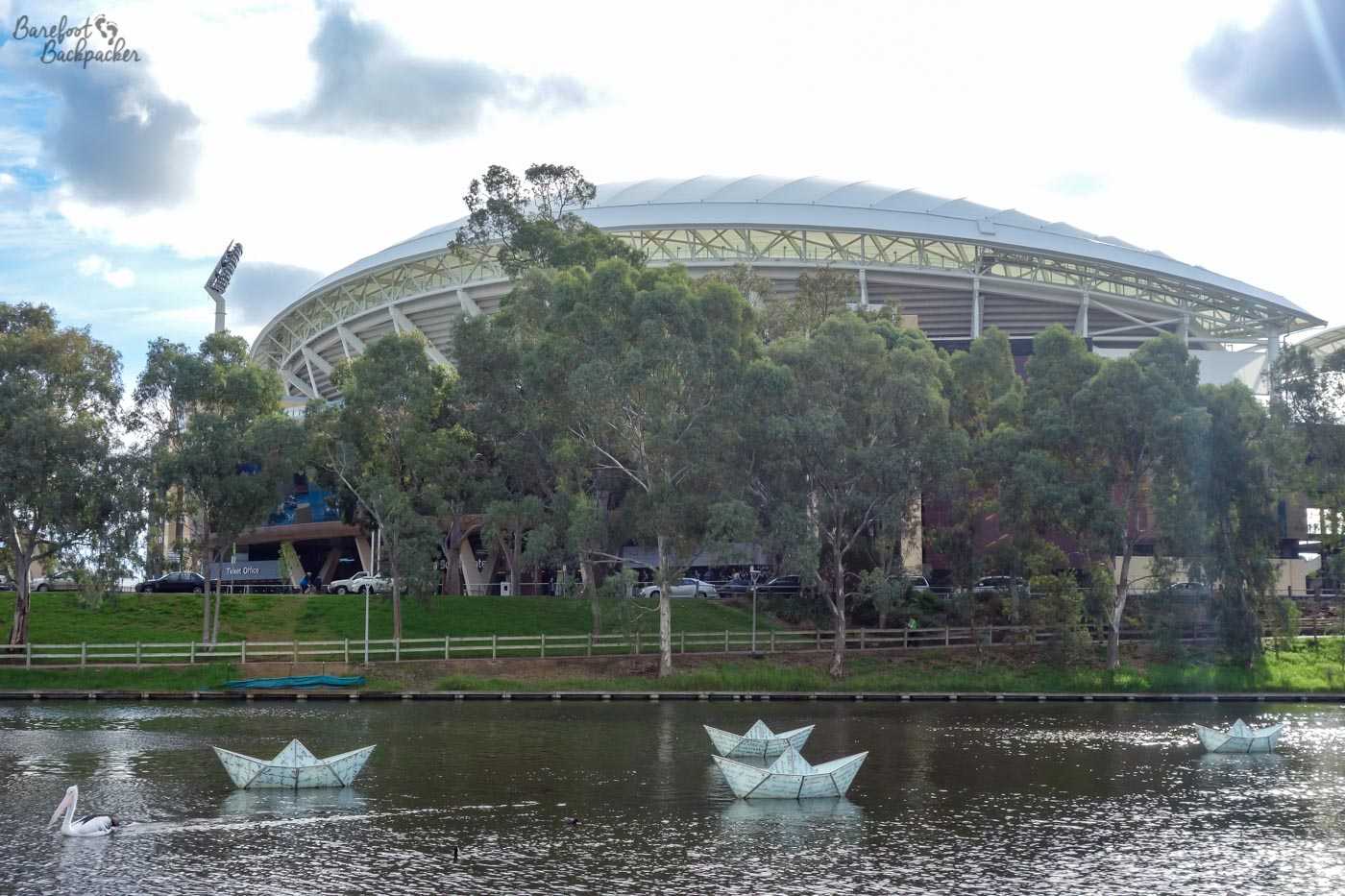
The Adelaide Oval cricket and AFL ground, as seen from the opposite side of the river.
The stadium’s in quite a nice spot – just outside the city centre and surrounded by parkland. In fact, Adelaide city centre as a whole is a bit like that – probably more than any other city I’ve been to, it embraces its green space; the central grid itself being almost entirely surrounded by parks and gardens.
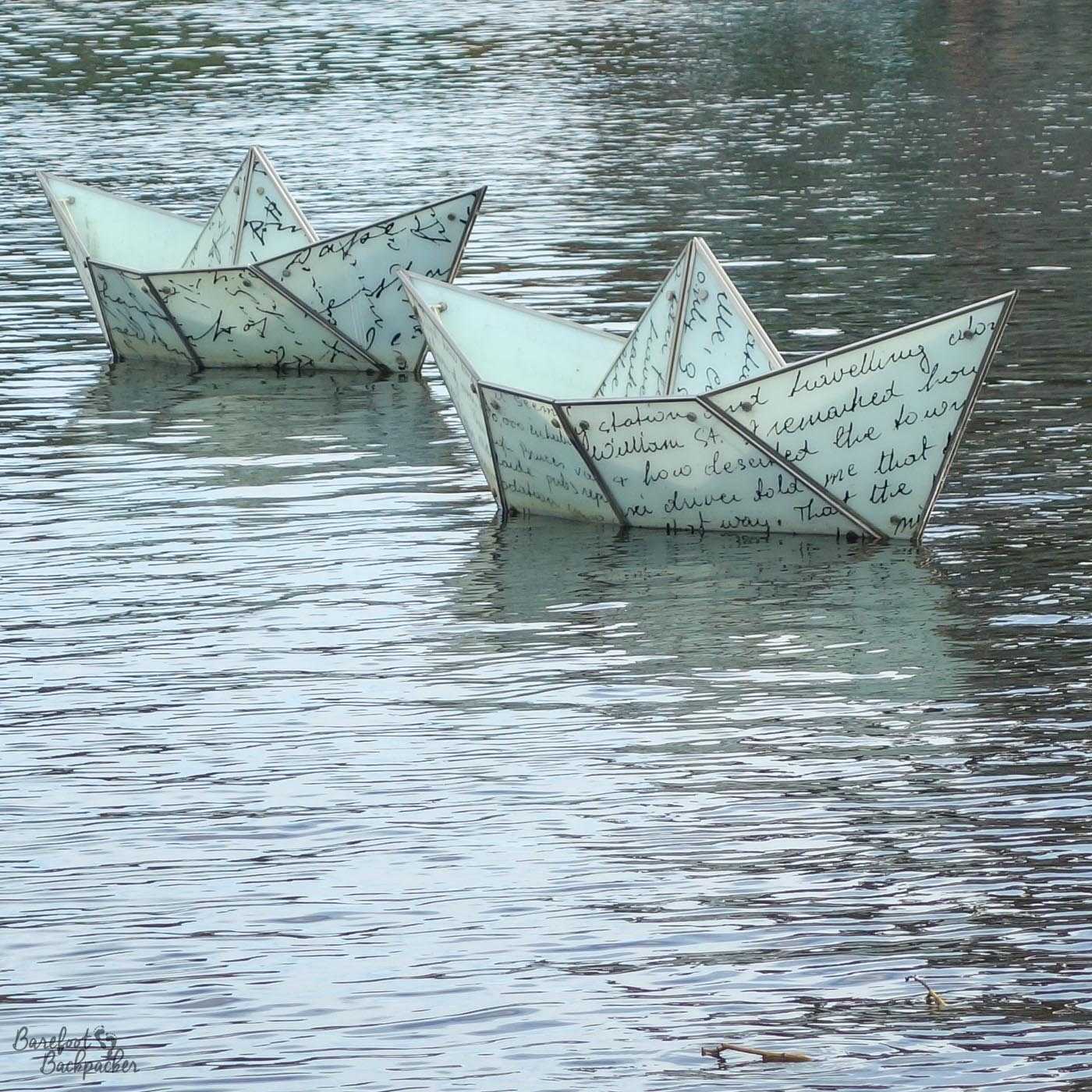
Two small boats making up part of the ‘Talking Our Way Home’ exhibit.
These parks are also the home to more public art, including an exhibit on the river by the Oval, called ‘Talking Our Way Home’, a series of origami-style glass ‘boats’ by the artist Shaun Kirby, who emigrated to Australia from the UK as one of the ‘ten pound poms’ in the 1960s. It’s designed to invoke imagery and feelings of transport and journeys. We’re all on a journey, after all.
I accidentally timed my visit to Adelaide to coincide with a small cultural festival, which I only found out about upon check-in at the hostel. Every year the city, like Edinburgh, has a Fringe Festival, with all manner of comedians, musicians, and performance art. This was not it; rather this was a kind of mini-fringe a couple of months later in the year. The month long ‘Cabaret Fringe Festival’ saw a few venues play host to some creative types; not on the scale of a huge event but still noteworthy.

Carla Conlin, performing on stage.
I went to two performances over two of the nights I was there. My first was a one-woman show called ‘Where’s My Pony? (And Other Stories of Betrayal)’. This was the brainchild of singer/dancer/comedian Carla Conlin, where she talks all the about hope and betrayal as you’re growing up – starting with the promise of a pony when she was 5 years old. I found her pretty cool, with a great voice, and much of what she said resonated with me – she largely spoke from a position that I’d been a few years previously – bitter twisted cynicism with a lot of debt.
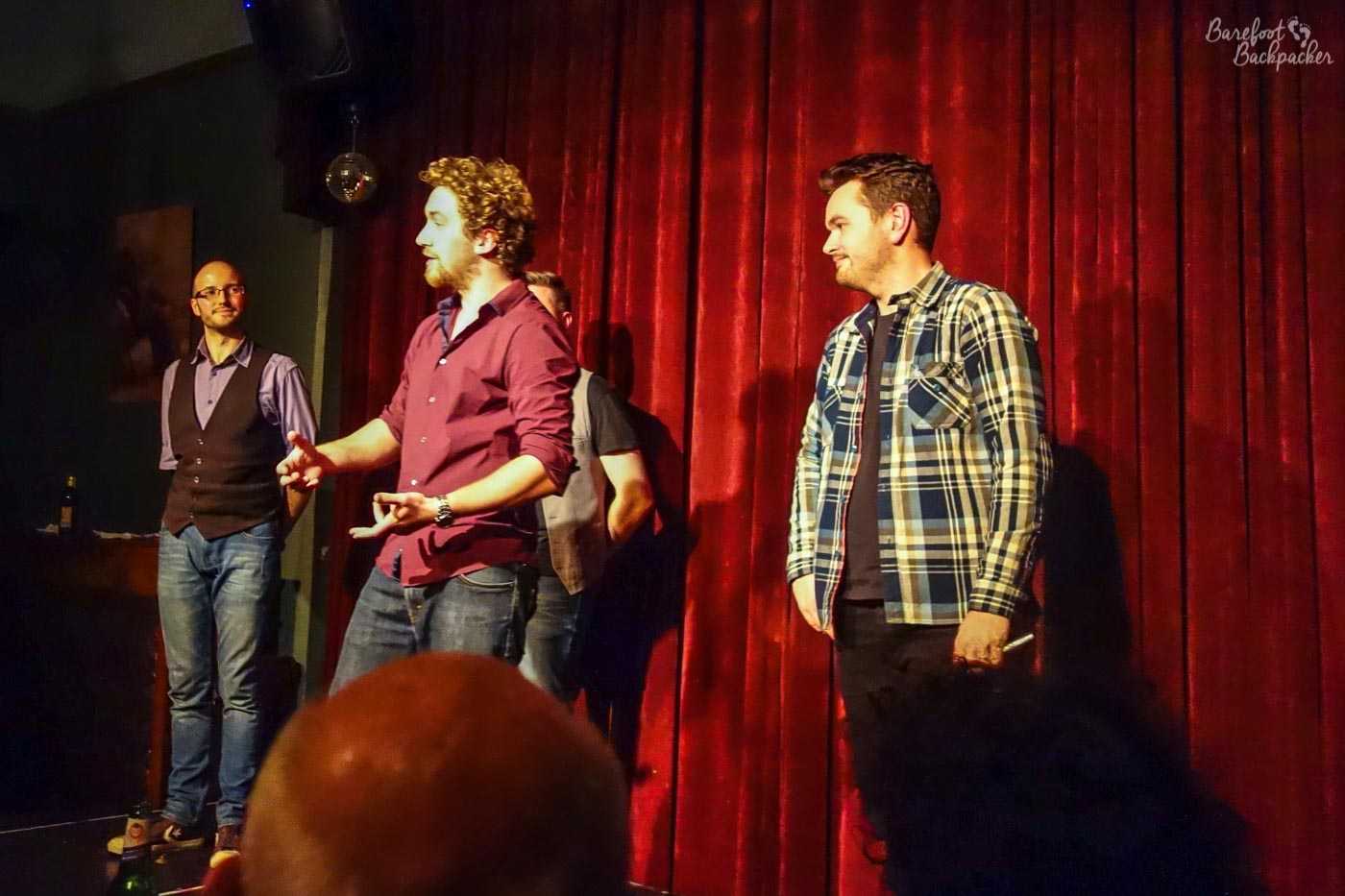
The ‘Changing Jennifers’, performing on stage.
The night after, I went to a show by a Comedy Improvisation troupe called the “Changing Jennifers” – despite their name they were a group of four 20-something guys who seem to be locals. They acted out a whole improvised story for an hour based on the suggestion of the audience, and it worked pretty darned well. In writing this blog post, I even found a review of the specific show I went to – I seem to remember voting for “The Book With No Pages”. It’d been a while since I saw any improv comedy – I used to go to a monthly performance in Nottingham at the start of the 2010s but they all moved on. I’ve always liked that sort of comedy but it’s one I could never do – my brain simply doesn’t work quickly enough.
Oh I Do Like To Be Beside The Seaside
I’m not quite sure why, but I do seem somewhat attracted to the sea. Maybe it’s because it’s something I’m used to (having grown up in a seaside resort), or maybe it’s just because it’s an easy and usually pretty day out.
Adelaide is built by the sea – although the centre of the city is, in a straight line, about 10km from the seafront, the city suburbs stretch quite a way along the Gulf St Vincent – an inlet off the ocean. Two notable places along this coast are Glenelg to the southwest, and Port Adelaide to the northwest.
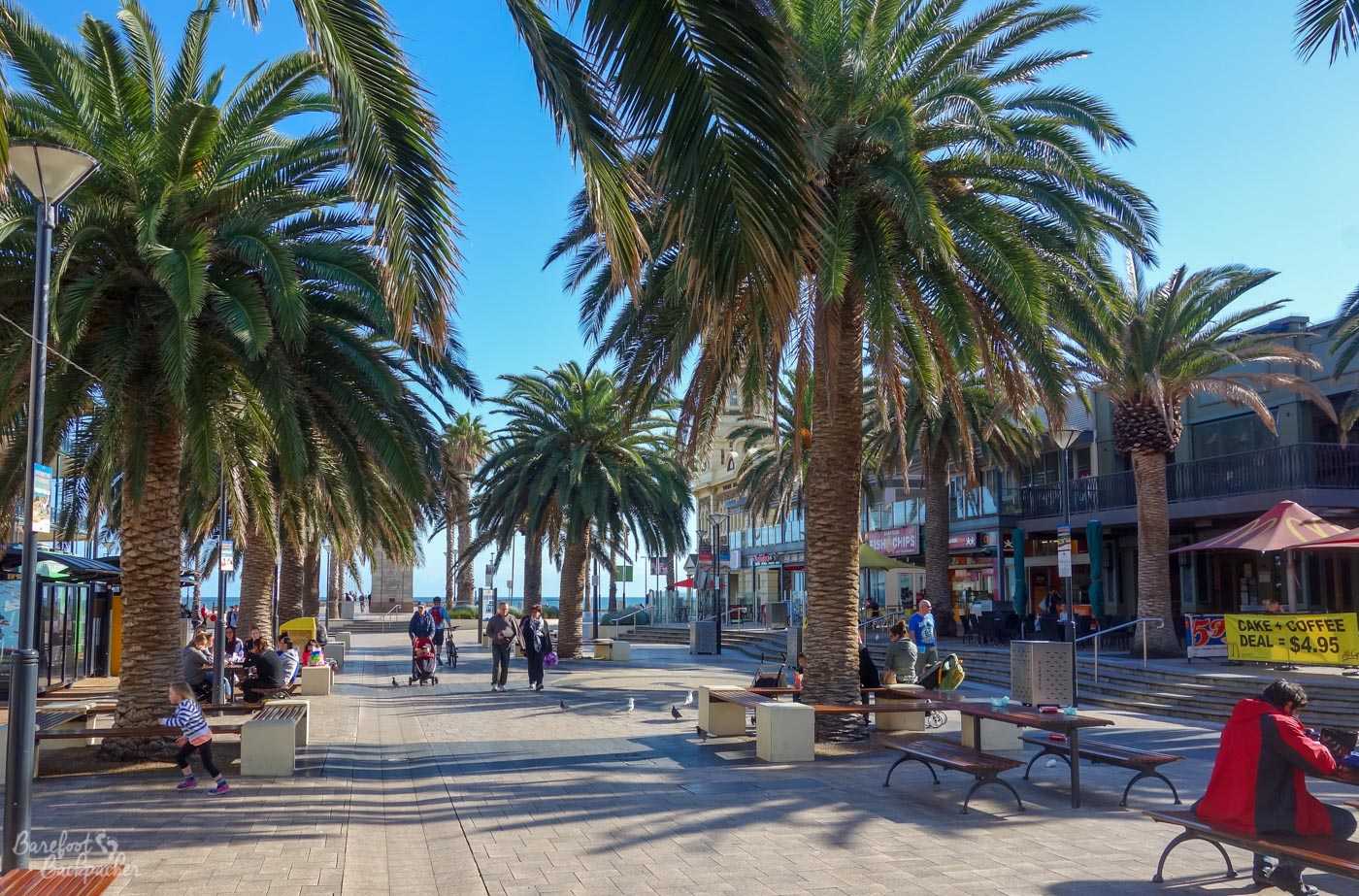
The main road in Glenelg that runs down to the water.
Glenelg is easily accessible from Adelaide by local tram. Funny story, however: on the morning of my visit, I discovered that due to an ‘incident’, the tram line was closed. It turns out that the ‘incident’ was an on-the-run fugitive who’d holed himself up in a brothel just off the tram line two stations down (and about 10 minute walk from the hostel) with four hostages. Exciting times. Note that by the time I made my way back, the situation had ‘cleared’; the fugitive ended up releasing his hostages and then shooting himself dead.
I went by bus.
The town is named after Lord Glenelg, who at the time of the foundation of the town in 1836 held the post of Secretary of State for War and the Colonies in the British government. It has the feel of a traditional British seaside resort, with not so much a high street but a ‘parade’ of shops with upper verandas, a pier (which they call a jetty), and with ice-cream shops as legion.
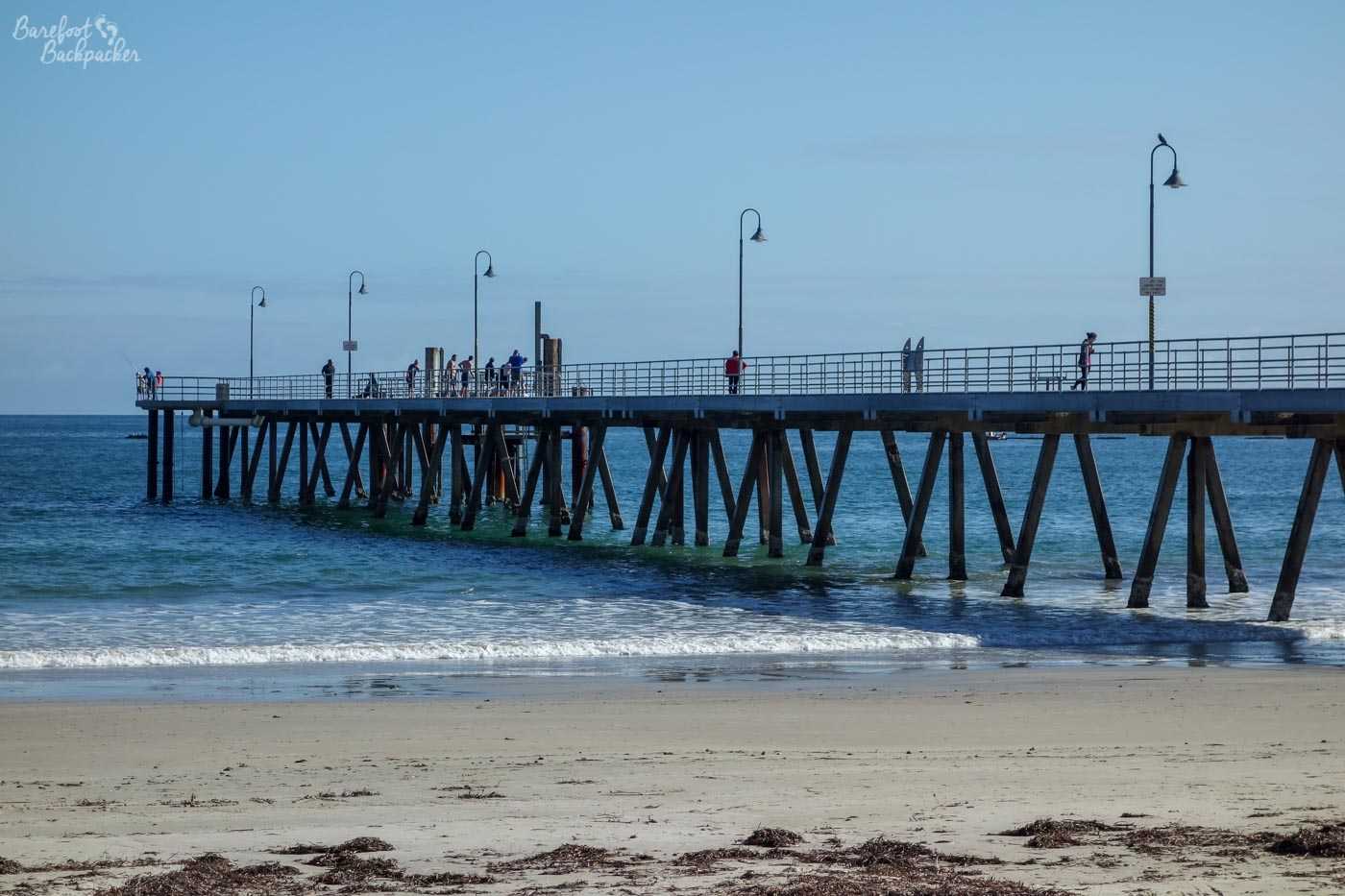
Glenelg pier.
It’s interesting to compare and contrast with Fremantle, which occupies a similar niche to Perth as Glenelg does to Adelaide. While Fremantle has beaches, most of the larger ones are a little way out of the town centre, and the central area itself is more a party-zone. Conversely, Glenelg’s high street and indeed tram line pretty much end on the beach – it’s a short straight walk from the tram directly to the pier. And the beach is quite large; and very definitely a proper beach.
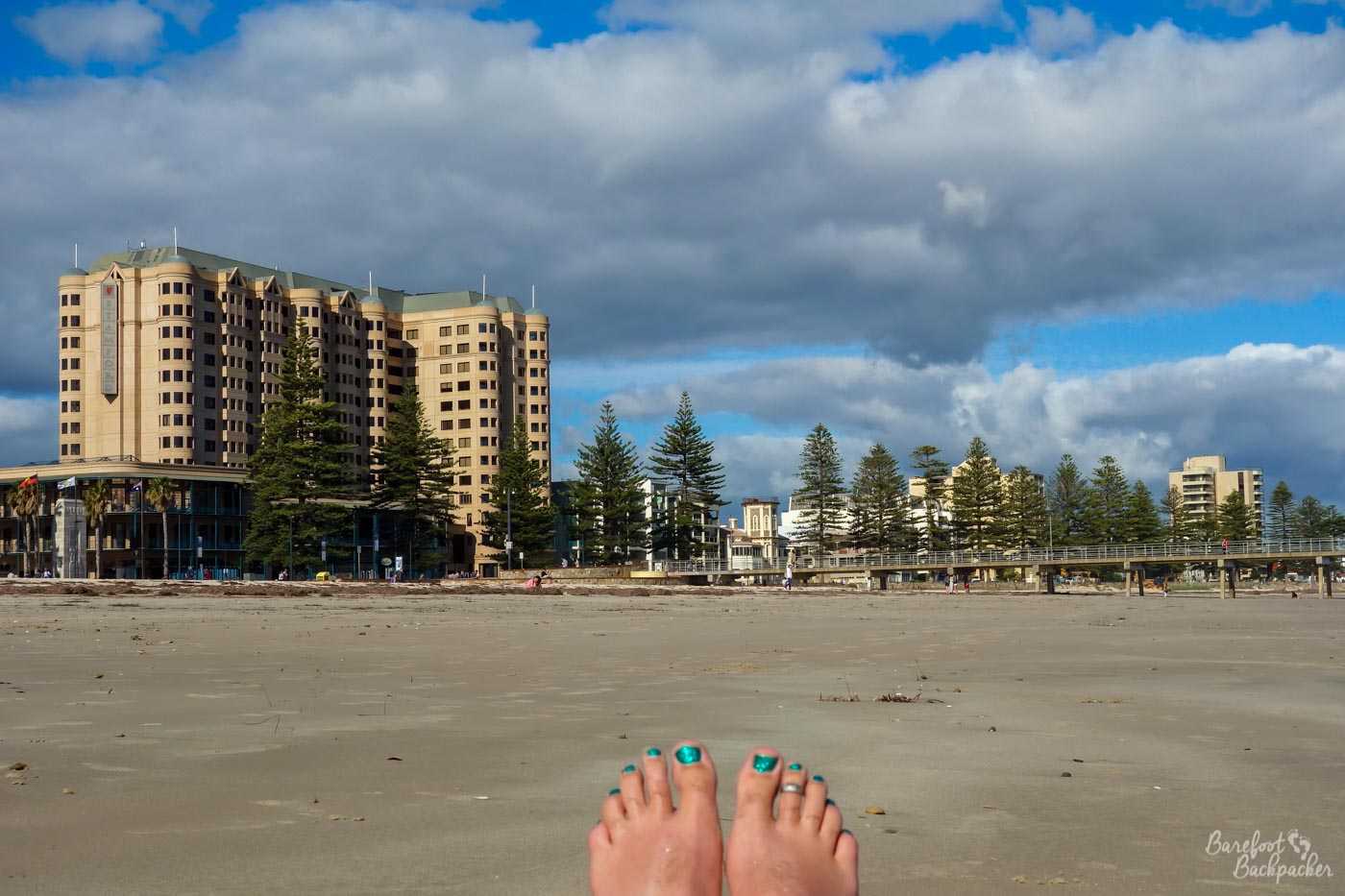
Glenelg beach. Feet in shot because it’s a beach.
Apart from being a beach bum, or loitering in the cafés, there’s not a lot to actually do in Glenelg, but that’s not the point, and certainly wasn’t the purpose of my visit. I had a nice chilled mint chocolate drink and then a bit of a sit on the beach, just nicely chilling and relaxing. It’s something I don’t do enough of – I rush around a lot when I travel, and don’t give me enough time to rest.
Port Adelaide is the harbour area of Adelaide, and pretty much where the original settlement was. It’s a sprawling area, with the heritage zone at the harbour a couple of km away from the beach and seaside area of Semaphore. Which is an odd name for a town with no readily apparent railway connection, yes. I had no issues that morning with raving gunmen, so getting up there wasn’t a problem. This time I took a local train up there, and caught the bus back. It was a nice easy ride, past both areas of industrial activity and rows of single-storey suburbia. It must be said the route to Glenelg was prettier and, I’d say, more affluent.

The jetty/pier at Port Adelaide, the rest of the town in the distance.
There’s a couple of museums in Port Adelaide that I’ll talk about in the next section, but close by the Maritime Museum was a lighthouse, which could be climbed using a narrow winding spiral staircase. From (almost) the top, there were good views across both the town and the immediate harbour area.

Port Adelaide harbour as seen from the top of the lighthouse.
Semaphore has a very long pier/jetty that sticks out quite a way into the sea, at the end of which were several people fishing. There’s a whole host of regulations along the Australian coast as to what and how much of each type of fish you can catch, to ensure sustainable fishing. Obviously while I was there, I had a fish and chips from one of the many chippies along the road to the beach.
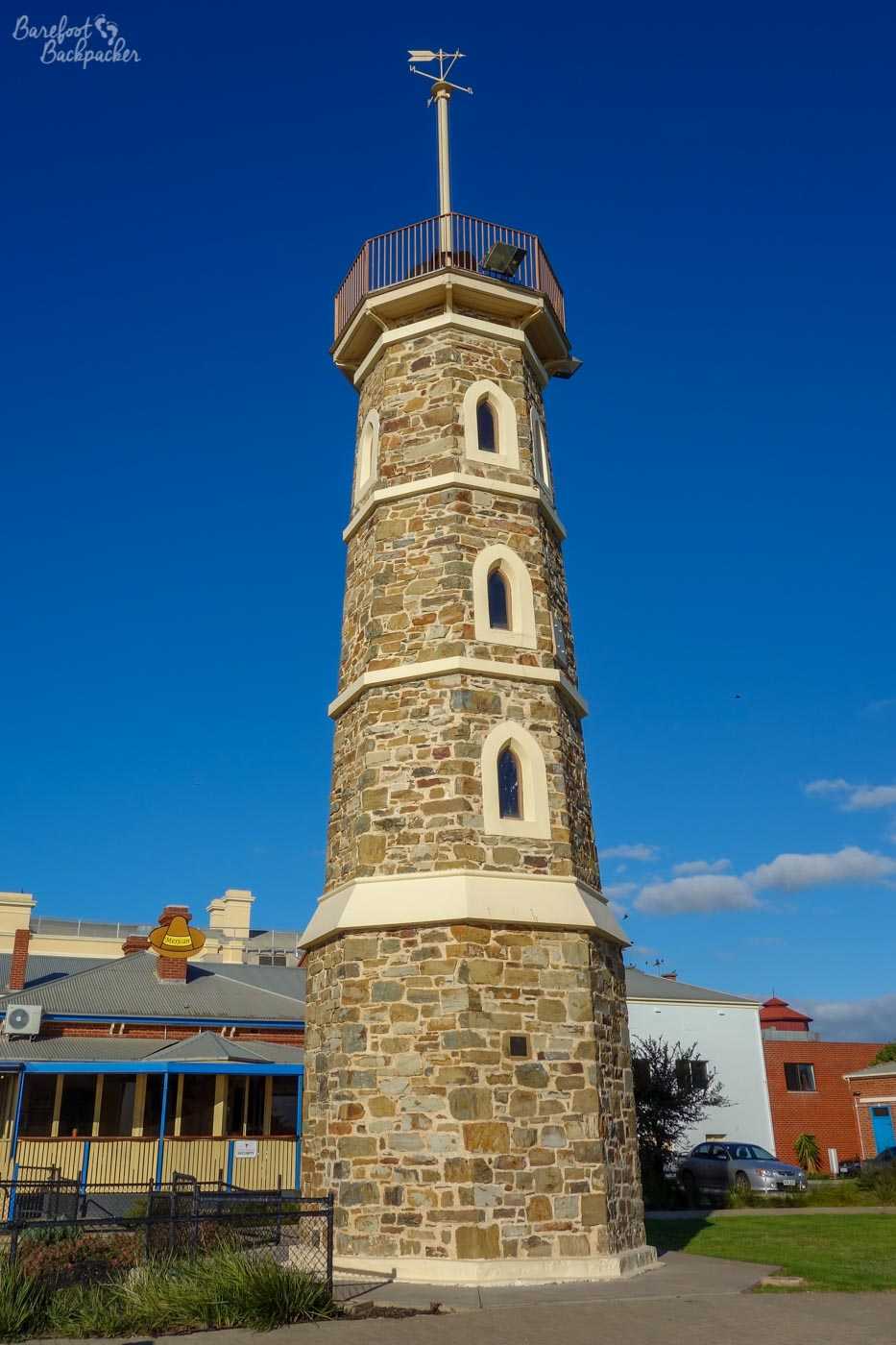
The time ball tower at Port Adelaide. A black ball was hoisted to the top at 12.57pm, and dropped at 1pm automatically by a signal from the nearby observatory. A way to mark the time in the days before wireless signals, never mind electronic personal timekeeping devices, it ceased being used in 1932.
Museums in the Adelaide area
“Haul away, you rollin’ King
Heave away, haul away
Haul away, oh hear me sing
We’re bound for South Australia”
(a sea shanty going by a myriad of titles, Trad., arr lots of people inc Pogues)
There’s a number of interesting museums in the Adelaide area of specific and local interest. One such in the centre of Adelaide is the ‘Migration Museum’. This is devoted to all the people who, since the area was first settled in 1836, have come to South Australia to live. There are sections covering the early settlers, the ‘ten-pound-poms’, and modern-day refugees.

Statue of an immigrant family at the Migration Museum.
Another museum in the city centre is the large ‘South Australian Museum’ and associated Art Gallery. Now, I didn’t go around the whole of the museum, being as you can see ancient Egyptian memorabilia anywhere, and stuffed mammals don’t interest me that much, however the two floors full of Aboriginal art and ephemera were my main draw, because that’s generally not the sort of thing you get to see in Nottingham.
I’m going to do a post all about both colonialism and immigration into Australia as a ‘deep dive’, but certainly both these museums were interesting and somewhat eye-opening – despite (or more likely, because of) being British, I never got taught what we did in our colonies, and we certainly don’t get told anything about the native populations of, well, anywhere. It’s all quite literal whitewashing, so it’s nice to see at least some admission of guilt in these museums.

The entrance to the South Australian Museum.
The rest of the South Australian museum gave a holistic overview of the flora and fauna of Australia. It showed the different types of land in the country, what lives/grows there, and how everything copes with the environment – including a particular exhibition on sea life.
Australia really is a difficult country to live in – with weather and landscape extremes (it’s not just that much of it is desert and scrubland, but also in the North you get a monsoon season). South Australia itself is pretty ‘calm’ compared to the rest of the country, but you don’t have to go far to reach the desert. And yes, there’s that whole stereotype about how everything in Australia is trying to kill you (spiders, snakes, box jellyfish); this pretty much applies to the weather as well as the animals – you do not go into the Outback alone.
Port Adelaide has museums of note too; the first I went to was the Maritime Museum, quite a large museum built on three levels.
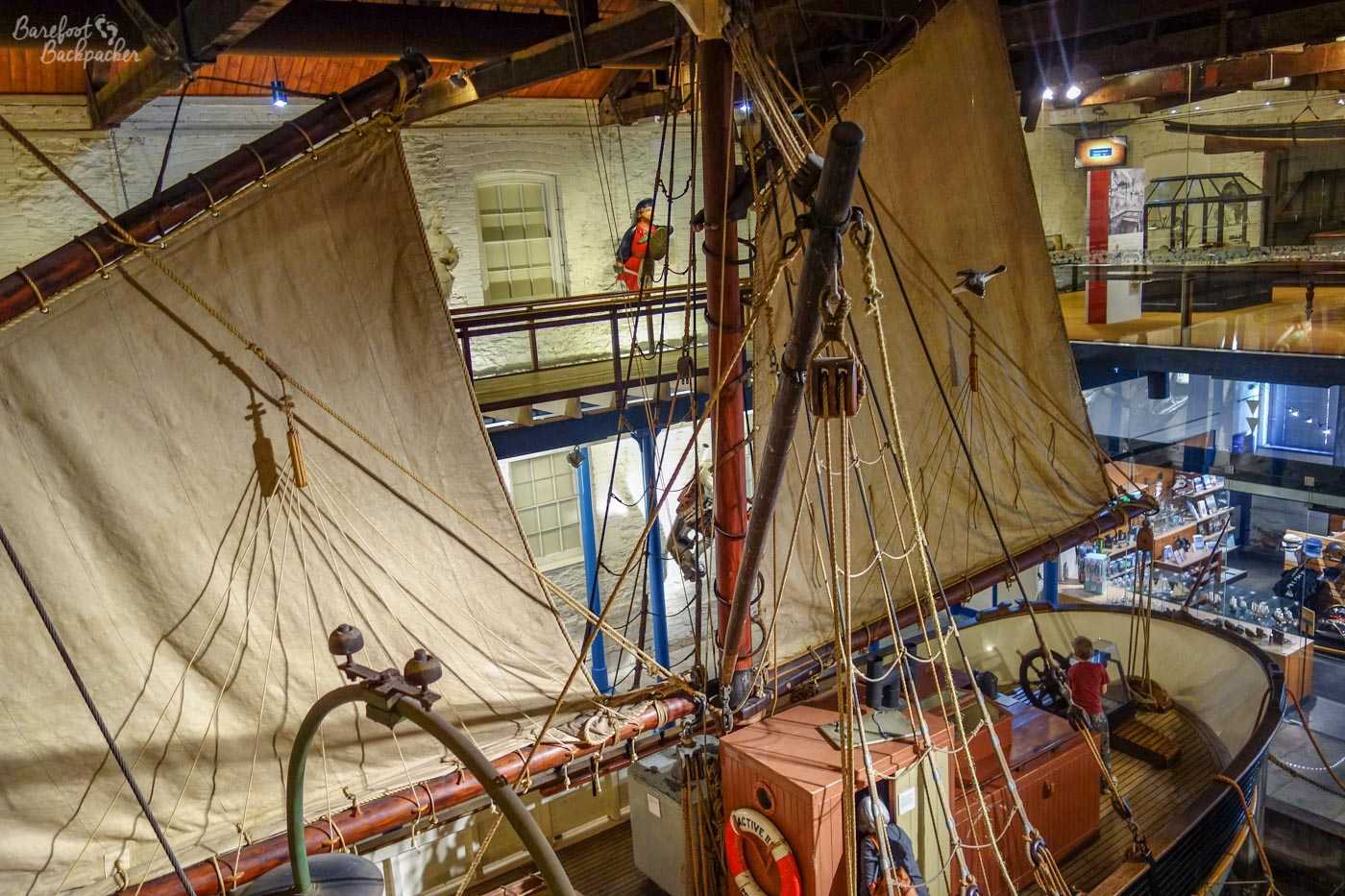
Old-fashioned sailing ship in the Maritime Museum.
There were several sections to the museum; one area talked about the local boats (the ‘Mosquito Fleet’) that used to sail around the islands and the coastline around Adelaide; small independent trading boats that zipped around like mosquitoes. This included a full-scale replica of one of the boats, which was very cramped inside.
Another large section looked at health and medicine at sea, with specific reference to the boats that traversed the route from the UK to Australia, but also looked at the role of the ships surgeon (who was expected to perform miracles but in the early days was considered one of the lesser crew members and even had to buy his own instruments, until gradually at the start of the 19th century people started to realise and accept their importance to a successful voyage), and a little bit on the battle against scurvy (mmm, citrus).
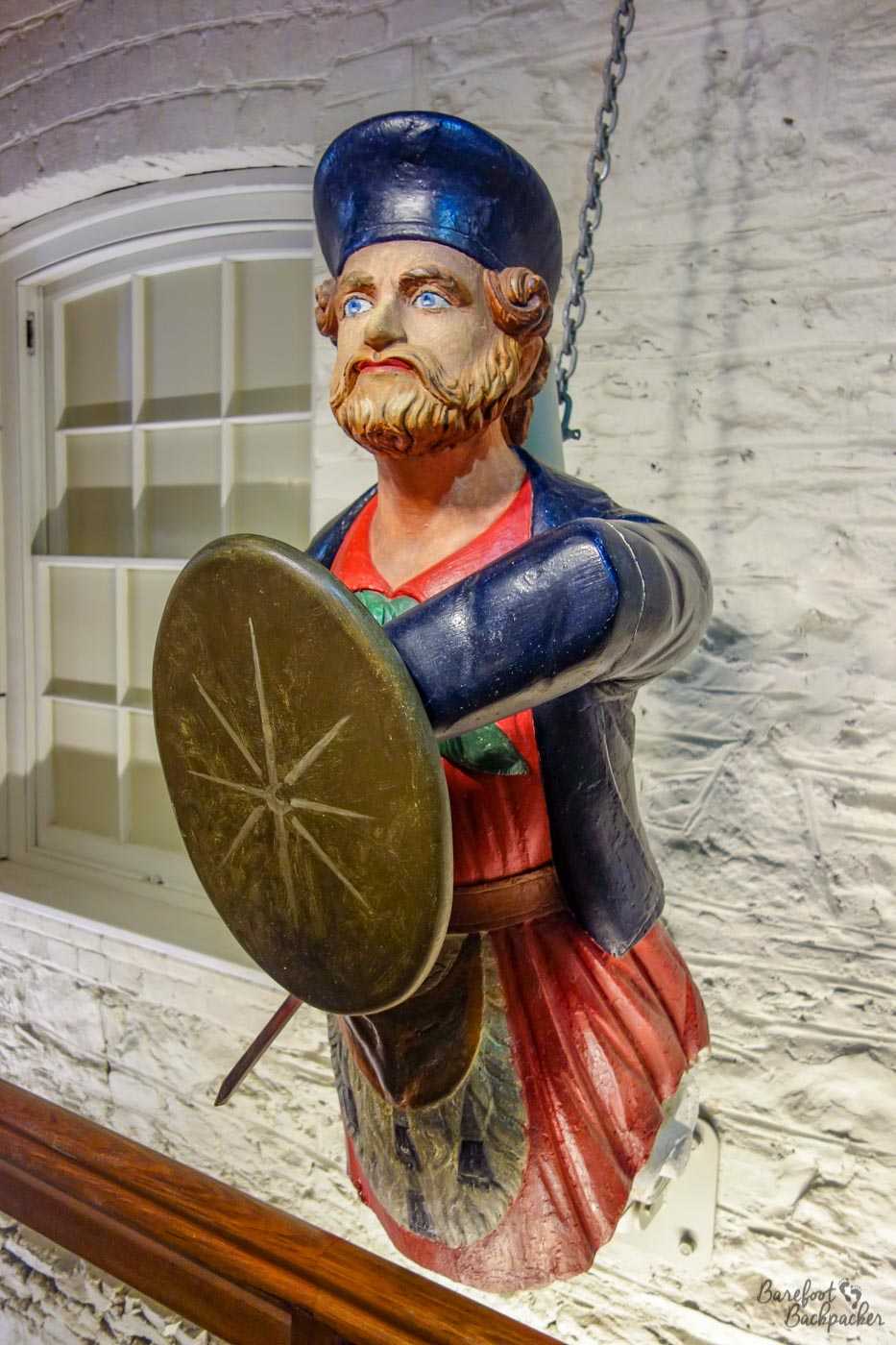
Ship’s figurehead on the wall of the museum; one of several on display.
There was also a little bit on the development of Port Adelaide as a town, from initial settlement to eventual stagnation (the town’s a little more ‘rough and ready’ than Adelaide city proper).
The other museum I visited was the Railway Museum, a little way out of town. It seemed apt, given I’d come to Adelaide on the train from Perth.
It was a pretty large museum, with all manner of trains and engines. Indeed, there was a miniature railway that weaved its way around the yards, allowing you to take a view of all the rolling stock they have, not just the ones in the main part of the museum.
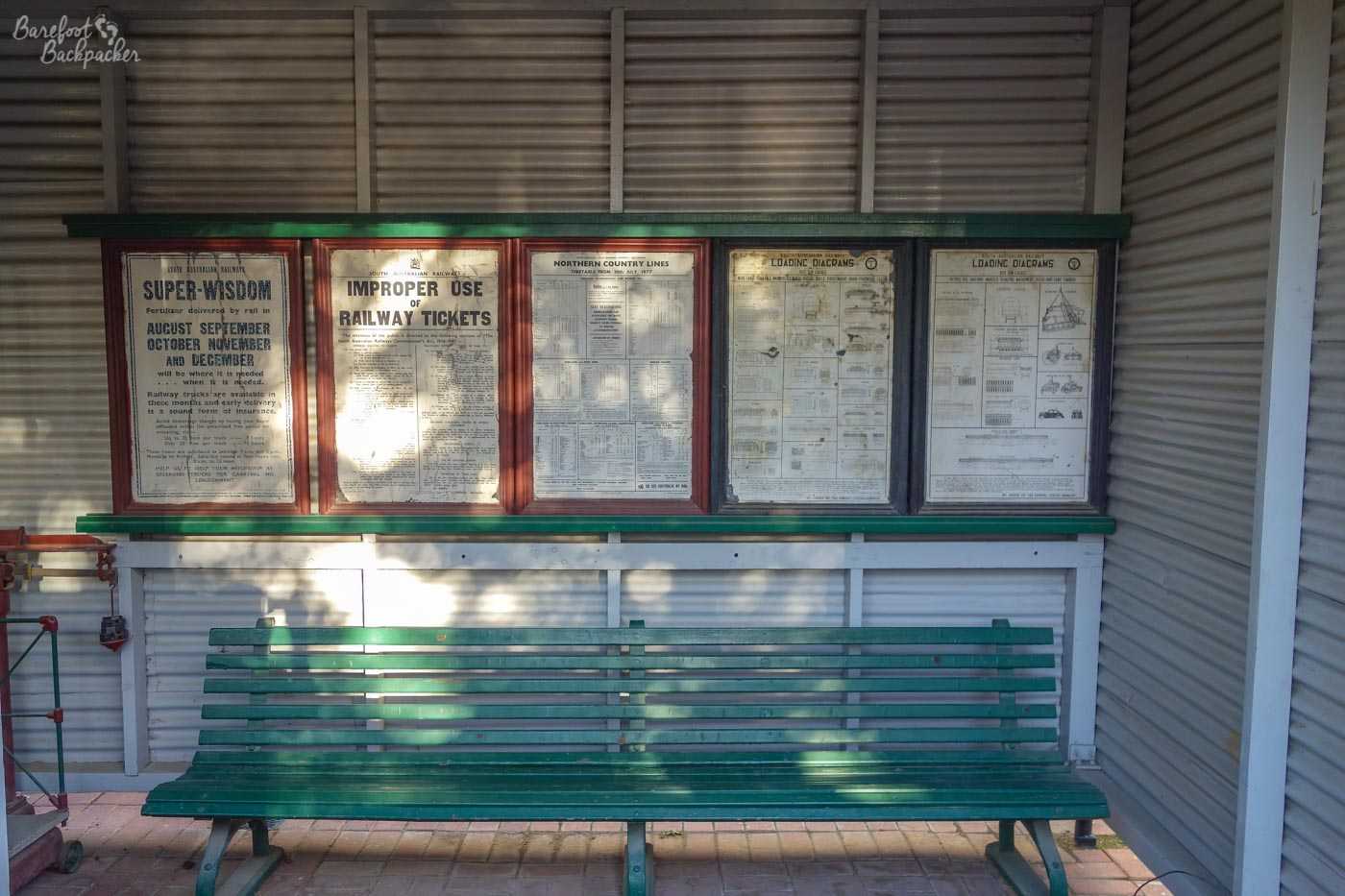
Replica platform shelter with old-fashioned information posters.
Inside the museum itself they have period train carriages and engines from across Australia, replica ticket offices, and lots of history of railways in Australia, with specific reference to the Trans-Australian railway line that the Indian Pacific now traverses. It turns out that route was vital for the cohesion of the Australian Confederation in the first place – Western Australia were dragging their heels on integration, but were happy to join as long as they got a West-East rail service.

Steam Engine given the identification number ’97’, on display at the museum. Obviously.
One of the major problems in the history of Australian railways, and why the Indian Pacific is so new, is because for almost the entirety of its presence, Australia has run its trains on three different rail gauges; indeed there’s still a couple of lines today that operate on the ‘wrong’ gauge. Each of the states of the Confederation developed their rail networks separately, based on advice from different sources. This meant that, for example, Victoria used a narrow ‘gauge’ whilst NSW used a ‘broader’ one. By the time tracks reached the borders and linked up with each other, it was too late to rip everything up and start again. This caused … issues, as you can probably imagine. Certain stations had to be built (like that at Port Pirie, where the line across South Australia met the Trans-Australian heading to Perth), sometimes in the middle of nowhere, to allow passengers and freight to transfer from one gauge to another.
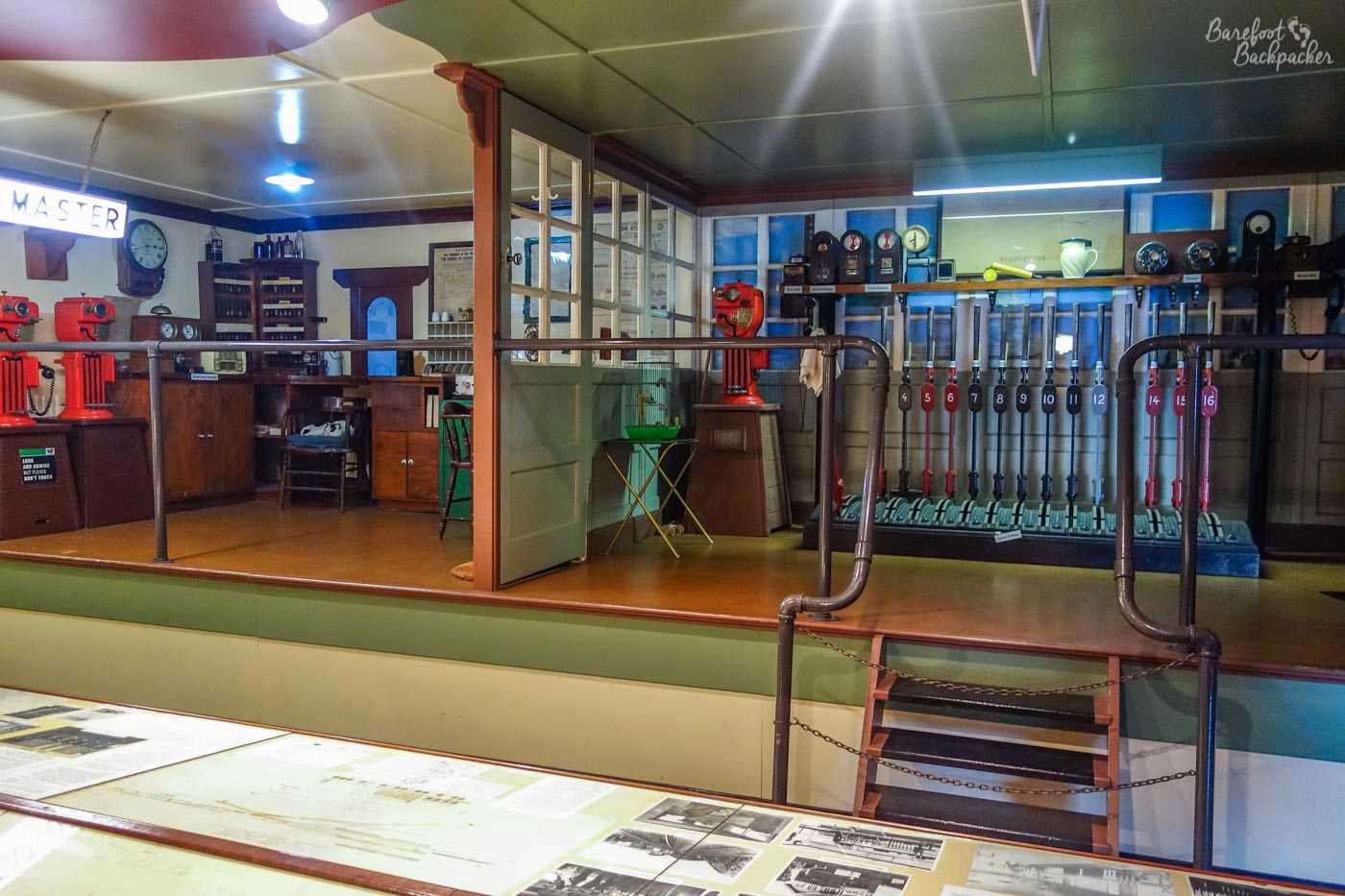
Replica stationmaster office and signal box.
Conclusion
So, is Adelaide boring? There are those who say yes, it is. I say it’s very relaxed, calming, and chilled, without the high adrenaline rush of other places in the country. Anyway, everywhere is boring if you have the wrong attitude.
So, no, Adelaide is not boring. Just don’t expect a wild time.